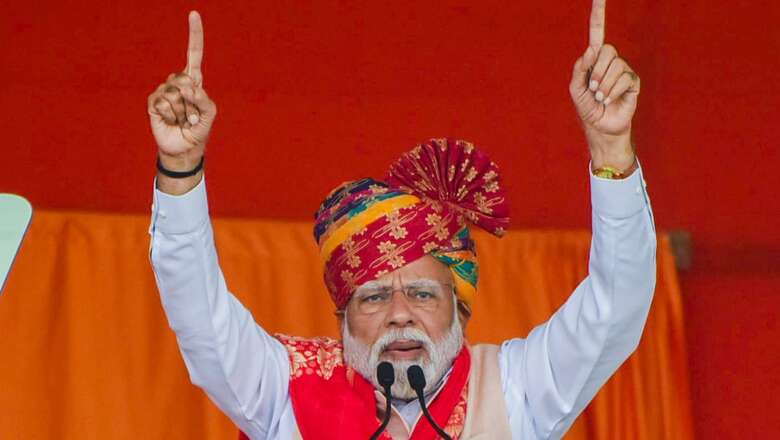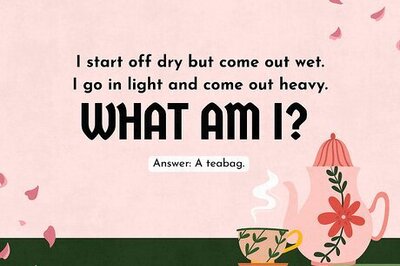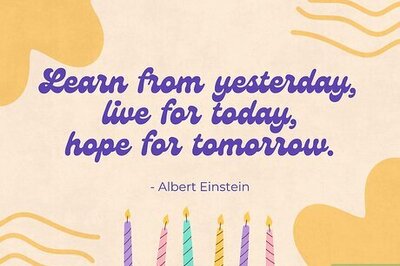
views
We were all prepared for the humbling of the BJP. The Congress, influential pundits and even the Exit polls had predicted an insipid BJP performance in this round of assembly elections. But it didn’t pan out like it was predicted, has it?
The BJP surprised and how. The saffron party has bagged 3 out of the 4 large states and poured cold water all over what was to be Congress’s coming out party before 2024.
The triumph is even more remarkable when one considers that in Madhya Pradesh (where it has been in power for 19 years) and Chhattisgarh the BJP has scored its best-ever tally. In Rajasthan, the Congress has been left to rue what could have been as the decidedly disorganized BJP pulled up its socks, literally at the last moment.
Even in Telangana where it is relegated to the third place the BJP has more than doubled its vote share and pocketed 10 seats.
By pulling off a grand victory against massive odds Prime Minister Modi has shattered 5 myths.
Myth 1: Brand Modi is imploding
After the Himachal and Karnataka elections the consensus among the Opposition was that Modi was no longer capable of rescuing the BJP. That his connection with voters had weakened despite BJP’s felicity at “’image management".
Perhaps keen to nip this perception in the bud, the Prime Minister made the surprise decision to visibly turn the election into a referendum upon himself.
This was an act of pure bravado. Even supporters of the BJP would agree that in Chhattisgarh and Rajasthan the BJP was looking decidedly jaded and by putting himself virtually on the ticket Modi was taking a huge risk.
In Madhya Pradesh, the situation was even more dire as the BJP was facing anti-incumbency and had clawed to power through the back door in 2019 after initially losing the election.
The BJP was so unsure of its satraps that it didn’t even project a chief ministerial face in any of these states.
But in the end “Modi ki Guarantee" (BJP’s campaign slogan) was enough for the voters.
With the result endorsing the durability of PM’s brand appeal only the very brave will bet against the BJP sweeping 2024.
Myth 2: Rural poor are yearning for change
Economists of a certain stripe and the BJP’s political opponents never stop selectively citing data to establish that Modi’s NDA has let down the poor. Long obituaries have been written on how rural discontent is going to spell the end for the BJP in 2024.
But the facts show that the BJP has won handsomely in rural seats in this round of elections. In Madhya Pradesh, out of a total of 194 rural seats the BJP won 137. In Rajasthan, out of 174 rural seats the BJP won 97. Clearly, the conversion rate proves that there is no significant rural anger against the BJP. Presumably the NDA’s targeted welfare schemes are having a palliative impact.
Myth 3: Enhanced Quota lifeline urgently needed for vulnerable castes
The Opposition was counting heavily on winning votes by promising a caste census. The Opposition hoped that the promise of a caste survey would help it hand out sops, euphemistically dubbed “haq" (right) linked to the real “abaadi" (population) of the Backward Classes. Rahul Gandhi and his alliance cohorts believe that the quotas are needed because the BJP’s ‘sabka saath’ promise is a hollow one. The Gandhi scion alleged that the BJP’s inherently upper caste bias leaves out the most vulnerable minorities. But this allegation has also not found takers.
EBCs, SCs and STs who are perhaps most economically and socially vulnerable and would have stood to gain the most from enhanced quotas, have voted for the BJP in the Hindi belt.
In Madhya Pradesh the BJP won 51 of 67 OBC seats and 27 of 47 tribal seats. In Chhattisgarh the BJP won 5 of 10 SC seats and 19 of 29 tribal seats. In Rajasthan, the BJP has done even better by wresting 58 of 107 OBC seats and 12 of 25 tribal seats. The support for the BJP among these sections is proof that voters are aspirational and prefer empowerment over largesse.
More than that, voters recognise that social stability is linked to economic well-being. Hopefully, after voters have snubbed attempts to fan the fires of destabilizing competitive identity-based caste politics the Opposition will now abandon the idea.
Myth 4: BJP pays lip-service to Women voters
The BJP’s wins have established that the over whelming turnout of women voters in Madhya Pradesh and Rajasthan was an expression of their belief in “Modi’s Guarantees".
In MP, for instance, 18.3 lakh women voters cast their ballots, 2% more than last time. In Rajasthan, they have also pipped the men to the ballot.
The BJP was the first to spot the trend and has for years cultivated women ‘labharthees’ (beneficiaries) to take it from strength to strength.
Almost every welfare scheme unveiled by the BJP at the central or state level has a female component.
Shivraj Singh Chouhan in Madhya Pradesh made it a point to address women as “laadli behenas" (adored sisters), a play on several ‘laadli behena’ welfare schemes. Responding to the Opposition for pulling him up for not enthusiastically championing the caste census, the Prime Minister cleverly proclaimed that, for him, the foremost ‘caste’ in India is that of women. Gender, of course, is a primary identity and cuts across all castes.
Women voters have reciprocated the PM’s sentiment shattering another Opposition spun myth.
Myth 5: North-South electoral divide is deepening under BJP
It is true that the BJP has not yet been able to win the South like it has swept the North. But to cite this to suggest that the South is alienated from the NDA is to advance an invidious thesis.
As things stand, the BJP has 29 Lok Sabha seats in the South compared to the Congress party’s 30.
Results from Telangana show that the BJP’s acceptability is growing incrementally. Almost 14% per cent of the vote has been cornered by the BJP. This is double the share it secured in 2018. The enhanced vote share has translated into a gain of 9 seats for the BJP in the state.
In other southern states, particularly in Tamil Nadu and Kerala, there has been a rapid spurt in its membership.
History has shown that ideologically based parties take more time to translate support into electoral gain.




















Comments
0 comment